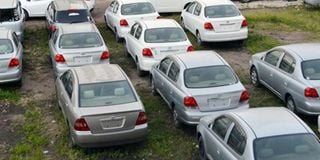Uganda import rule boosts Kenya car dealers

Imported vehicles at a yard in Mombasa. Kenya is also the only East African country with strict age limits on car imports, making vehicles in the country expensive and lucrative for the black market trade of selling cars meant for export locally.
Uganda has tightened import conditions for vehicles aged over nine years, a move that is expected to disrupt the automobile black market in Kenya.
It will, however, translate to improved fortunes for local dealerships long inconvenienced by smuggled units from the neighbouring country.
In a new directive by the Uganda Revenue Authority (URA), imports of vehicles older than nine years will from July 1, 2022, be cleared under the East Africa Community’s Single Customs Territory (SCT), which allows members of the bloc to jointly collect customs taxes.
“Pursuant to section 64 (k) of the East African Customs Management Regulations 2010, the Uganda Revenue Authority wishes to inform the general public that effective July 1,2022 motor vehicles of nine years old or more from the date of manufacture shall no longer be cleared under the warehousing regime,” URA said in a notice seen by Smart Business.
“The customs clearance of such motor vehicles shall be facilitated under the Single Customs Territory arrangement where taxes will be paid upon arrival at the port of entry into the East African Community,” the Ugandan taxman added.
Uganda market
Currently, importers of vehicles destined for the Uganda market are allowed to store their units in holding units approved by tax authorities—commonly referred to as bonded warehouses-- pending payment of customs duties.
This has been popular with many Ugandan importers because it eases liquidity pressure on them and encourages them to import more units some of which are later dumped in the more lucrative Kenyan market by crafty dealers.
Most of the used cars sourced from Uganda, though cheaper, are much older than those in the Kenyan used vehicles market because Kampala had not put an age limit on imported second-hand automobiles.
This implies that one can ship in a much older car through Uganda, declare low custom value and pay much lower taxes compared to direct importation into Kenya where the maximum age limit on used cars has been set at eight years—meaning that the car market in Kenya has newer and pricier vehicles.
Under the SCT system, however, conditions will be tougher for Ugandan importers. In this regional scheme, importers in each of the EAC partner States are required to lodge import declaration forms in their respective home countries and pay relevant taxes upfront to facilitate the export process.
Cross-border movement
Respective revenue agencies would then issue a road manifest against the import documents submitted electronically by tax officials of the importing country to allow cross-border movement.
This is expected to have an impact on the cash flow of many auto dealers in Uganda, and discourage them from importing large numbers of the cheaper, older, and low-quality vehicles which are popular with buyers in the black market, especially in western Kenya.
In Kenya, only new vehicles are kept in bonded warehouses while second-hand vehicles have to pay duty within 21 days or start attracting extra charges.
Kenya Auto Bazaar (Kaba) secretary-general Charles Munyori, however, said Uganda’s move may not fully impact the black market trade unless the region adopts the same standards.
“It will only work if Uganda and Kenya make explicit limitations and the time limit is at par, otherwise Uganda still allows older vehicles just that you pay more,” he said.
Kenya is also the only East African country with strict age limits on car imports making vehicles in the country expensive and lucrative for the black market trade of selling cars meant for export locally.
EAC member-states have failed to enforce proposals to lower the age limit for imported used cars to five years by 2021.
Uganda’s move is a measure to bring the country’s car age limit closer to the EAC resolution that had recommended the slashing of the age limit for imported cars to five years by 2021.
It was only in 2018 that Uganda passed a law limiting the importation of vehicles manufactured more than 15 years ago.
Eight years
Kenya has been pushing regional countries towards adopting the EAC recommendation and has already announced plans to limit the age of used vehicles with engine capacity above 1500cc imported to five instead of the current eight years.
Tanzania allows imports of cars as old as 10 years while Burundi, Rwanda, and South Sudan, on the other hand, have no formal age limits for used cars. The different set of age limits within the region has fuelled tax and regulatory arbitrage to ship in cheaper and older cars.
Many Kenyans are reportedly involved in a tax and regulatory arbitrage to ship in cheaper and older cars.
Recent raises in car import duties have made the Kenyan black market attractive for dealers in the region.
Car traders in Kenya are currently caught in a legal fight with the Kenya Revenue Authority (KRA) which had in July 2020, published a new Current Retail Selling Price (CRSP) -- a database of prices of new vehicles in the country that forms the basis of taxing second-hand units after taking into account depreciation.
Car Importers Association of Kenya, which represents 80 dealers of used vehicles, moved to court and got orders suspending implementation of the new catalogue.
The dealers argue that the new CRSP is inflated and has the potential to increase the final prices of some car models by hundreds of thousands of shillings.
The Court of Appeal this month extended a freeze on KRA's move to raise taxes on used motor vehicle imports by adjusting the base on which various levies are computed.
The suit over the higher taxes comes as used car prices in Kenya have jumped by an average of 37 percent over the past six months as demand outstrips supply globally on production cuts.
This has pushed the cost of low-end vehicles such as Nissan Note and Toyota Vitz above the Sh1 million mark.
The prices of used vehicles are dependent on many factors, including dealer margins, the age of the car, and a series of cumulative taxes.
The tax value is calculated based on the CRSP -- which should match showroom prices -- for that specific model, adjusted for depreciation at a rate of 10 percent per year. Insurance and freight charges are added to the adjusted CRSP to arrive at the customs value.
The vehicle then attracts an import duty of 25 percent, excise duty (ranging from 25 percent to 35 percent), and value-added tax of 16 percent, payable cumulatively and in that order.
A higher CRSP quote has the effect of inflating taxes and the ultimate yard prices of second-hand cars. The association obtained showroom prices independently and compared them with the KRA's list to build its case, the court was told.





